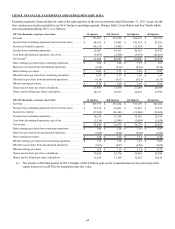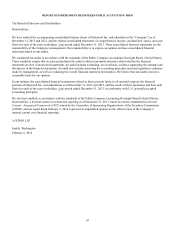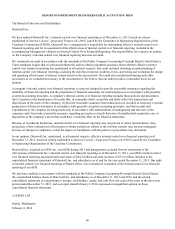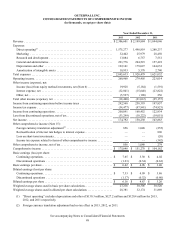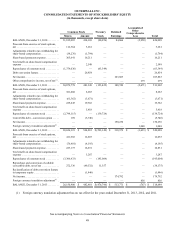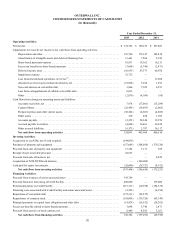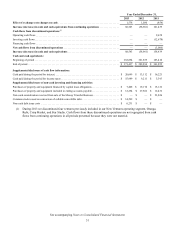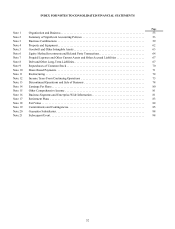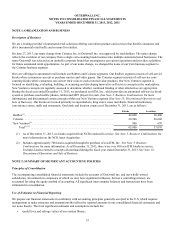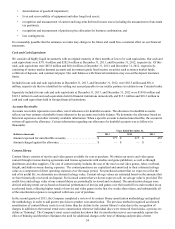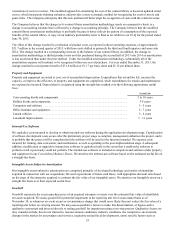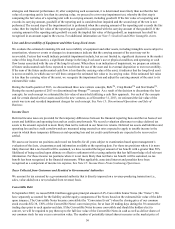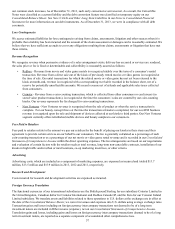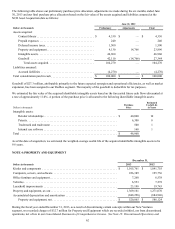Redbox 2013 Annual Report Download - page 63
Download and view the complete annual report
Please find page 63 of the 2013 Redbox annual report below. You can navigate through the pages in the report by either clicking on the pages listed below, or by using the keyword search tool below to find specific information within the annual report.
54
• determination of goodwill impairment;
• lives and recoverability of equipment and other long-lived assets;
• recognition and measurement of current and long-term deferred income taxes (including the measurement of uncertain
tax positions);
• recognition and measurement of purchase price allocation for business combination; and
• loss contingencies.
It is reasonably possible that the estimates we make may change in the future and could have a material effect on our financial
statements.
Cash and Cash Equivalents
We consider all highly liquid investments with an original maturity of three months or less to be cash equivalents. Our cash and
cash equivalents were $371.4 million and $282.9 million at December 31, 2013, and December 31, 2012, respectively. Of this
total, cash equivalents were $65.8 million and $60.4 million at December 31, 2013, and December 31, 2012, respectively,
consisting of money market demand accounts and investment grade fixed income securities such as money market funds,
certificate of deposits, and commercial paper. Our cash balances with financial institutions may exceed the deposit insurance
limits.
Included in our cash and cash equivalents at December 31, 2013, and December 31, 2012, were $85.5 million and $91.8
million, respectively that we identified for settling our accrued payable to our retailer partners in relation to our Coinstar kiosks.
Separately included in our cash and cash equivalents at December 31, 2013, and December 31, 2012 were $199.0 million and
$123.3 million in cash and cash equivalents held in financial institutions domestically and $15.3 million and $18.3 million in
cash and cash equivalents held in foreign financial institutions.
Accounts Receivable
Accounts receivable represents receivables, net of allowances for doubtful accounts. The allowance for doubtful accounts
reflects our best estimate of probable losses inherent in the accounts receivable balance. We determine the allowance based on
historical experience and other currently available information. When a specific account is deemed uncollectible, the account is
written off against the allowance. Certain information regarding our allowance for doubtful accounts was as follows (in
thousands):
Years Ended December 31,
Dollars in thousands 2013 2012 2011
Amount expensed for uncollectible accounts. . . . . . . . . . . . . . . . . . . . . $ 177 $ 417 $ 455
Amount charged against the allowance . . . . . . . . . . . . . . . . . . . . . . . . . $ — $ — $ —
Content Library
Content library consists of movies and video games available for rent or purchase. We obtain our movie and video game
content through revenue sharing agreements and license agreements with studios and game publishers, as well as through
distributors and other suppliers. The cost of content mainly includes the cost of the movies and video games, labor, overhead,
freight, and studio revenue sharing expenses. The content purchases are capitalized and amortized to their estimated salvage
value as a component of direct operating expenses over the usage period. For purchased content that we expect to sell at the
end of its useful life, we determine an estimated salvage value. Content salvage values are estimated based on the amounts that
we have historically recovered on disposal. For licensed content that we do not expect to sell, no salvage value is provided. The
useful lives and salvage value of our content library are periodically reviewed and evaluated. The amortization charges were
derived utilizing rental curves based on historical performance of movies and games over their useful lives and recorded on an
accelerated basis, reflecting higher rentals of movies and video games in the first few weeks after release, and substantially all
of the amortization expense is recognized within one year of purchase.
In the second quarter of 2013, the Company completed a review of its content library amortization methodology and updated
the methodology in order to add greater precision to product cost amortization. The previous method recognized accelerated
amortization of content library costs at a rate faster than the decline in the content library's value due to the recognition of
charges in addition to the normal rental curve amortization whenever individual discs were removed from kiosks, a process we
define as "thinning". The Company's most recent analysis has shown that its amortization curves can reasonably capture the
effect of thinning and therefore eliminates the need for additional charges at the time of thinning and provides a better


